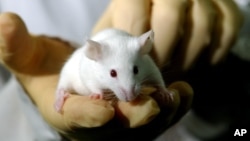There’s new evidence of a link between air pollution and some mental disorders, including autism and schizophrenia, say researchers who exposed mice to pollutants and found telltale changes in their brains.
Scientists from the University of Rochester medical school in New York state outlined their findings in the journal Environmental Health Perspectives, published online Thursday.
In initial studies, the researchers exposed certain mice to air pollution and then gave them behavioral tests.
Mice that breathed polluted air did worse on tests of mental functioning than mice that breathed clean air, said research leader Deborah Cory-Slechta, Ph.D. The ones exposed to pollution did worse in a learning test. And the results were the same when they were tested for memory.
“You could see again there were deficits in that short-term memory,” Cory-Slechta said. “And those we also saw in both males and females.”
Testing physical effects
The research team decided to see if the pollution was having any physical effect on the laboratory animals’ brains. So they launched a new study.
When they examined the brains of the pollution-breathing mice, they found the lateral ventricles – part of the brain’s cerebrospinal fluid circulatory system – were two to three times the normal size.
In humans, this enlargement is associated with autism, schizophrenia and more, Cory-Slechta said. “It is an indicator of poor development. It is a prognosis for poor development of children with behavioral, IQ, cognitive, and other kinds of deficits that will persist.”
In addition, structures that communicate between left and right halves of the brain were not fully developed in the pollution-breathing mice.
The laboratory animals were exposed to polluted air just days after birth, and their brains were tested soon after. But the same impairment was found when the brains of several months-old mice were examined, indicating the damage does not go away.
Hazardous ultra-fine particles
The polluted air in this experiment was made up of ultra-fine particles, which are believed to be more dangerous because they are small enough to get deep into the lungs and into the bloodstream.
Cory-Slechta said her research may help explain why a number of other studies have shown a statistical link between air pollution and autism: “Our data basically, we think, provide a biological plausibility for that kind of association.”
Scientists from the University of Rochester medical school in New York state outlined their findings in the journal Environmental Health Perspectives, published online Thursday.
In initial studies, the researchers exposed certain mice to air pollution and then gave them behavioral tests.
Mice that breathed polluted air did worse on tests of mental functioning than mice that breathed clean air, said research leader Deborah Cory-Slechta, Ph.D. The ones exposed to pollution did worse in a learning test. And the results were the same when they were tested for memory.
“You could see again there were deficits in that short-term memory,” Cory-Slechta said. “And those we also saw in both males and females.”
Testing physical effects
The research team decided to see if the pollution was having any physical effect on the laboratory animals’ brains. So they launched a new study.
When they examined the brains of the pollution-breathing mice, they found the lateral ventricles – part of the brain’s cerebrospinal fluid circulatory system – were two to three times the normal size.
In humans, this enlargement is associated with autism, schizophrenia and more, Cory-Slechta said. “It is an indicator of poor development. It is a prognosis for poor development of children with behavioral, IQ, cognitive, and other kinds of deficits that will persist.”
In addition, structures that communicate between left and right halves of the brain were not fully developed in the pollution-breathing mice.
The laboratory animals were exposed to polluted air just days after birth, and their brains were tested soon after. But the same impairment was found when the brains of several months-old mice were examined, indicating the damage does not go away.
Hazardous ultra-fine particles
The polluted air in this experiment was made up of ultra-fine particles, which are believed to be more dangerous because they are small enough to get deep into the lungs and into the bloodstream.
Cory-Slechta said her research may help explain why a number of other studies have shown a statistical link between air pollution and autism: “Our data basically, we think, provide a biological plausibility for that kind of association.”






